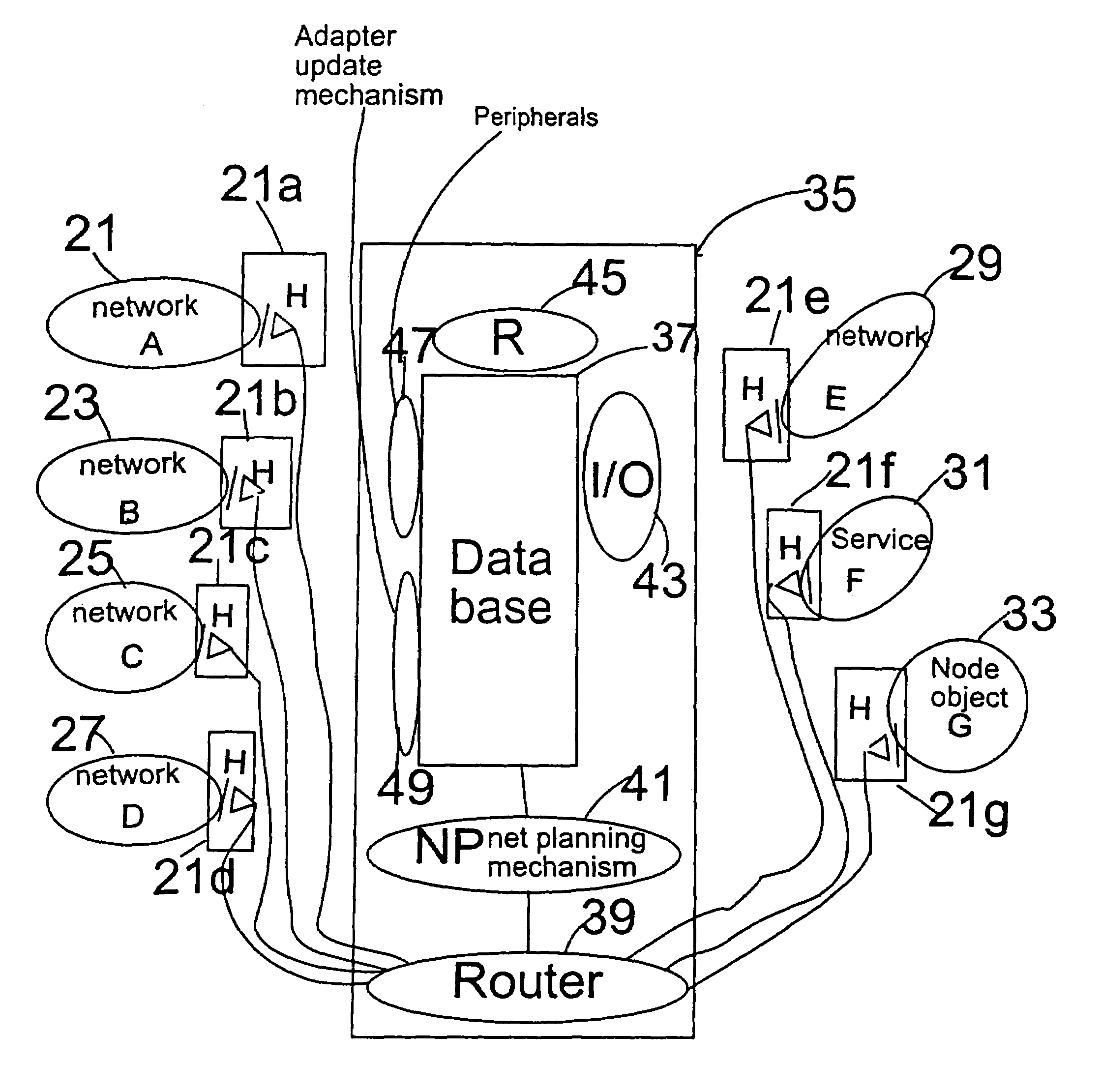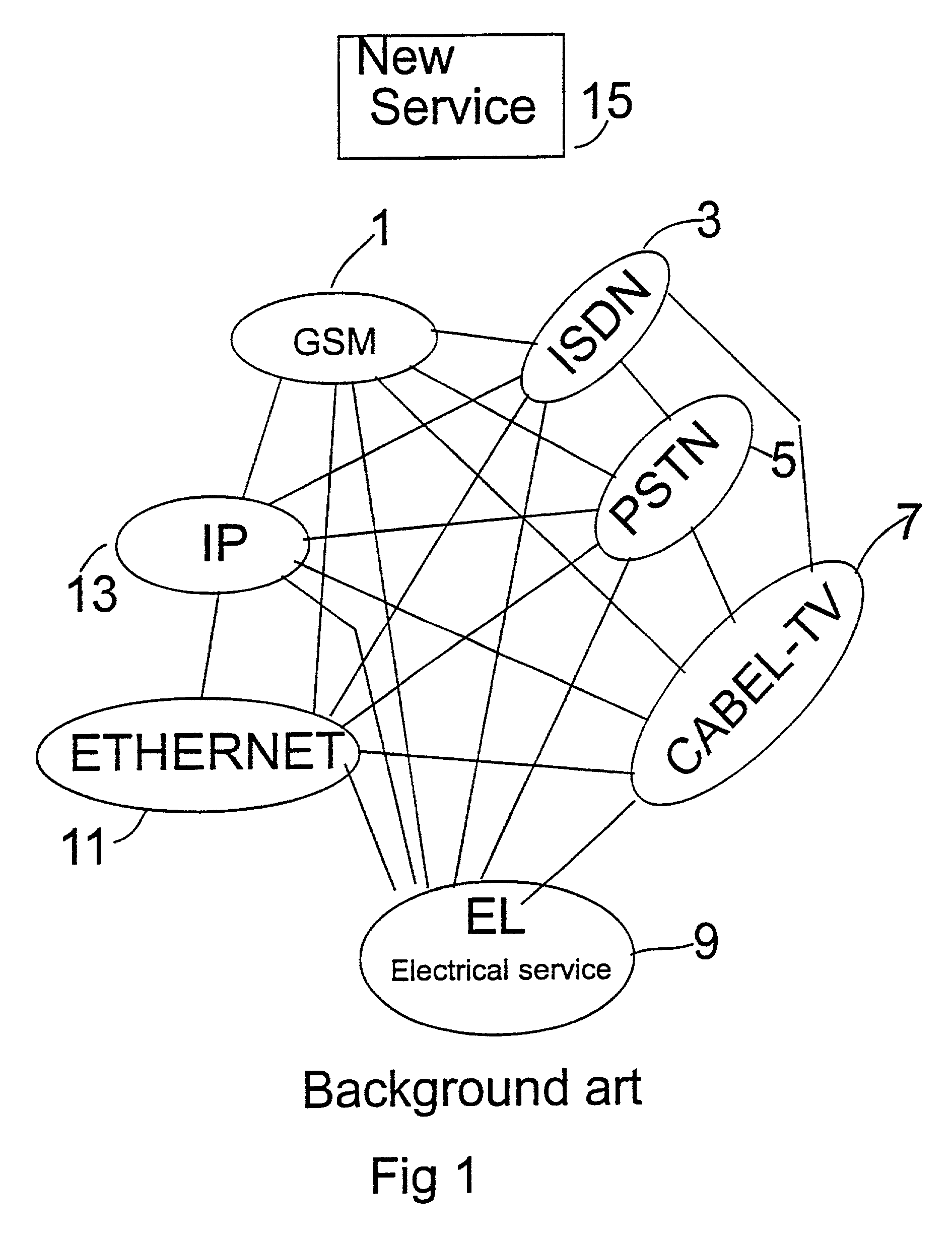[0014]The controller 35 includes a
router 39 (see e.g., FIG. 2) which is configured to receive information from the different objects to assist in the communication between objects. The controller also includes a
database 37 that hosts a
list of all the subscribers, their calling numbers in the different objects, and other attributes that may be of interest to the subscribers, for other parties who wish to contact or provide information to those subscribers. The controller 35 uses the database to identify which of the objects a given calling number should be directed. This information is received from the
router 39 and transmitted to the database 37, where the database 37 then retrieves the appropriate information regarding which services are identified for a particular subscriber at that time so the controller 35 will be aware of the subscriber's preferred mode of communication at any particular time. The controller 35 also sends control signals to the different objects (the calling party and the called party) so as to set up the service in question. To this end, the centrally based controller 35 facilitates the process for identifying a common protocol, where appropriate, for communication between the two different objects. This
system is facilitated in that the database includes information regarding attributes of the different objects.
[0016]The present invention also provides a method for providing a communications session between objects that are made up from different communication networks. The principles employed in the different objects are differentiated from one another based on the object's original information. Moreover, in a world that experiences an ever increasing number of different communications providers, the attributes of different communication providers, including even perhaps a small “mom and pop” communication provider will have unique attributes that will not be well-known to others in the
communication industry. Nonetheless, even such small companies and newcomers, in fields far from traditional telephone services, will be able to communicate seamlessly in the present system even though according to conventional principles, such systems may be completely different or incompatible with one another. To this end, a feature of the present invention is that the central
control equipment, is available to help facilitate the initial communication and even subsequent communications between the different objects, in attempting to ascertain whether or not a common protocol exists between the two networks, when trying to establish a call or service request. To this end, the controller identifies the objects and categorizes them according to the different working principles employed in the objects and provides a
verification that a translation at some part between the two different networks may be carried out in order for a communication session to be established. When the result of these processes is that the communication between the objects is guaranteed as services are accessible within one of the objects resulting in use of connections in another object. To assist in meeting this goal, initially, objects and the controller communicate with one another according to a predetermined protocol.
[0019]The inventive method, system and apparatus offers numerous advantages, one of which being that the present solution offers an alternative to establishing individual connections between systems when the systems themselves attempt to communicate information therebetween. In this way, the services offered by the different systems may be used jointly, such that traditional users of one object may employ available services from another object so as to increase the flexibility and available routing paths for distributing information to different subscribers. A feature offered by the present invention, is that subscribers themselves will have increased flexibility by being able to transport numbers associated with that subscriber from system to system even though that subscriber may move to a different area code, country, or even terminate subscription to one service and employ an offering made available by another service. Another
advantage is that the attributes associated with having a central controller with an accessible database, enables subscribers to preregister and adaptively change particular profiles regarding how and when that particular subscriber would like to receive information distributed from anyone of a variety of different calling services. For example, the subscriber may permit certain types of traffic to be connected to that subscriber's
residence at certain times of the day, but
route that same type of traffic to the subscriber's work location at other times of the day. Furthermore, a subscriber is thus able to monitor different types of calls in order to allow only certain calling services to get through during certain times and / or certain circumstances. For example, during dinner hours at the subscriber's
residence, the subscriber may choose to
route all information to a particular service that provides a message recording service rather than any service that presents an audible alarm that might annoy the user during dinner.
[0020]The present invention also greatly facilitates the incorporation of new communication services into a seamless information communication system that includes many of the traditional services, as well as new start-up networks.
 Login to View More
Login to View More  Login to View More
Login to View More 


